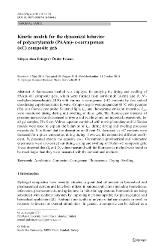Kinetic models for the dynamical behavior of polyacrylamide (PAAm)-kappa-carrageenan (kappa C) composite gels
Abstract
A fluorescence method was employed for studying the drying and swelling of PAAm-kappa C composite gels which were formed from acrylamide (AAm) and N N'- methylenebisacrylamide (BIS) with various kappa-carrageenan (kappa C) contents by free radical crosslinking copolymerization in water. Composite gels were prepared at 80 A degrees C with pyranine (Py) as a fluorescence probe. Scattered light I (sc) and fluorescence emission intensities I (em) were monitored during drying and swelling of these gels. The fluorescence intensity of pyranine increased and decreased as drying and swelling time are increased respectively for all gel samples. The Stern-Volmer equation combined with moving boundary and Li-Tanaka models were used to explain the behavior of I (em) during drying and swelling processes respectively. It is found that the desorption coefficient D (d) decreased as kappa C contents were increased for a given temperature during drying. However the cooperative diffusion coefficient D (s) presented exactly the opposite case. Conventional gravimetrical and volumetric experiments were also carried out during drying and swelling of PAAm-kappa C composite gels. It was observed that D (d) and D (s) values measured with the fluorescence method were found to be much larger than they were measured with the conventional methods.
















